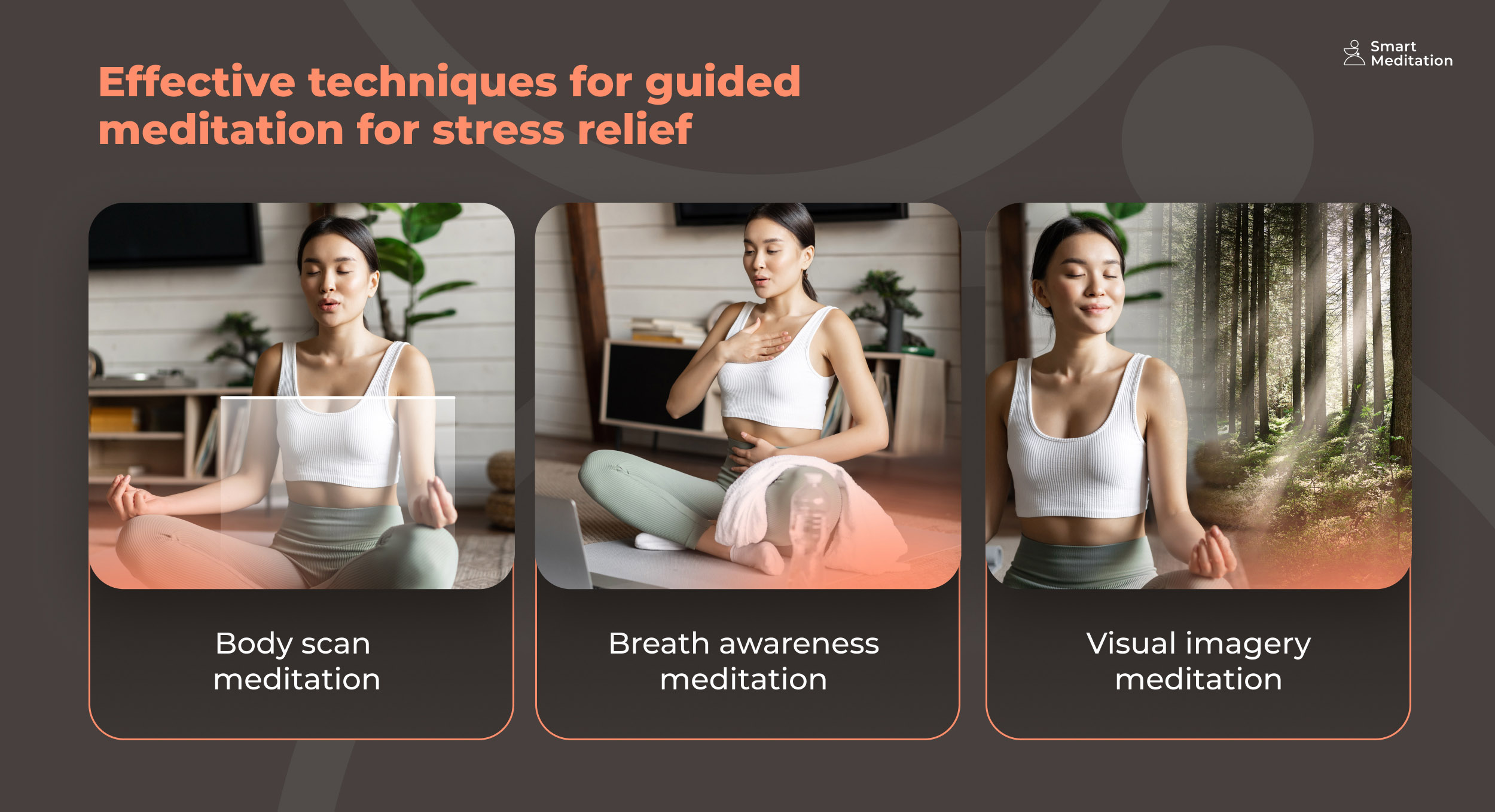
Guided Meditation for Stress Relief: Calming Scripts and Techniques
The art of meditation has existed for many centuries now and has kept evolving. Many new techniques, exercises and rituals have been adopted; however, what remained largely the same throughout is the master-student dynamic.
Undoubtedly, meditation can be both beneficial and enjoyable when performed alone in a special, serene place. At the same time, many believe it is when your sessions are helped by another person that your meditation is at its absolute best. The master, or a coach, provides a calming presence along with great insights and clear instructions to their student, enhancing the student’s meditation experience and making it next-level – this is known as guided meditation for stress relief.
In this article, we’ll delve deeper into the phenomenon of guided meditation, providing you with some techniques and examples as well as giving you tips on how you can integrate it into your daily routine.
Understanding Guided Meditation for Stress Relief
Guided meditation for stress relief is a special kind of meditation practice in which your sessions are accompanied by a third party that provides you with assistance or instructions. These sessions may take place online (through meditation apps, audio tracks, podcasts, live sessions with a coach) or in person (group meditation sessions, individual sessions with an instructor).
The reason why guided meditation is so effective is because whilst still having all of the benefits of other meditation types such as reducing stress, it has extra benefits of it own
- The directions given by an instructor are often very useful and make it simple to quickly pick up the art of meditation; and if you work with a live coach, you’ll also have the opportunity to ask questions and get clarity on any concepts that aren’t entirely clear;
- The instructor’s soothing voice can aid in creating a safe and supportive environment, removing the feeling of loneliness and fostering a sense of belonging;
- The flexibility of guided meditations allows them to often include and combine different techniques, such as mantras, loving-kindness, body scans, and mindfulness.
Effective Techniques for Guided Meditation for Stress Relief
Essentially, almost any existing meditation type can be guided – all it takes to have someone else to provide direction in your sessions instead of you doing it alone in silence. That’s why you can try out the following guided meditation for stress variations:

Body Scan Meditation
During body scan sessions your guide may follow this guided meditation for stress and anxiety script:
- Take a comfortable seating position and close your eyes;
- Give your full focus to one particular section of your body – for example, the instructor may want you to start with your head;
- Acknowledge for yourself how your head feels – does it feel tense or relaxed? You will be asked not to evaluate those sensations, just acknowledge them;
- After some time, travel your mind down your body, and proceed further with the exercise, now by scanning your neck;
- Repeat the process with each of your body parts, going from the neck down: shoulders, chest, abdomen, pelvis, thighs, legs and feet.
Breath Awareness Meditation
Guided meditation for stress relief also often comes in the form of breathing exercises. One of the most commonly used techniques for guided breathing is the 4-7-8 exercise where you’ll be asked to:
- Take a comfortable seating position and close your eyes;
- Start slowly inhaling as the instructor is counting to four;
- Once the count reaches four, start exhaling as the instructor resets the count as counts to seven;
- By the time the count reaches seven you should have exhaled every bit of oxygen;
- Simply hold your breath as the instructor resets the count once again and counts to eight;
- Once the count reaches eight, start inhaling again and repeat the cycle till the session is over;
Visual Imagery Meditation
To unwind, you can also use guided imagery – visualization of relaxing concepts and settings fed to you by the instructor. One of the most common places to cast your mind to in this meditation is a forest where you may be asked to:
- Take a comfortable seating position and close your eyes;
- Mentally put yourself in a serene forest, surrounded by many trees;
- Imagine songbirds, hopping from branch to branch and singing in a very relaxing way;
- Imagine the sunlight that barely passes through the crowns of the trees, only touching a few spots on the ground;
- See how the leaves and branches are moving as the gentle wind blows and rustles them;
- Once you’ve familiarized yourself with the setting, start walking through the forest, coming across some other interesting places like small ponds and rivers and interacting with them;
- Continue your journey through the forest until the instructor concludes your session;
Guided Meditation Examples
As mentioned above, guided meditation for stress can be enjoyed both online and offline. For the purposes of this article we’ll focus more on the high-quality material you can find on the Internet, namely our Smart Meditation app.
For instance, if you’d like to feel empowered and inspired at the start of your day, our app offers a range of great morning meditation tracks. They range from a simple 2-minute “Affirmations” exercise to a 20-minute track to help you build trust in yourself and set yourself up for success on any given day.
On the other hand, if your goal is to get better sleep, it may be a good idea to try out a couple of app’s 15-minute shavasana and yoga nidra sessions just before bedtime. They will enable both your mind and body to relax and get ready for fulfilling rest.
Lastly, if all you want is just to shake off some stress and feel better about yourself, our app will give you another great variety of guided meditation programs. Those include, but not limited to, 5-minute breathing exercises, 10-minute zen tracks and 20-minute anti-depression sessions.
Incorporating Guided Meditation into Daily Life for Stress Relief
Like any other meditation type, guided meditation for stress relief is best when it’s integrated into your daily routine and becomes part of your life. And while it’s not always easy, here are some tips you can follow to make this process as easy as possible:

Establishing a Guided Meditation Routine
Any consistency begins with setting up a schedule, and guided meditation is no exception.
It helps you maintain discipline and adds an extra bit of healthy responsibility, which is good for developing a sense of dedication to your sessions. Also don’t put too much pressure on yourself – “regular” doesn’t equal “every day”, so you can still stay consistent even if you plan to meditate only every other day.
Exploring Guided Meditation Apps and Resources
Nowadays one of the best and readily available sources of guided meditation material are special meditation apps. For instance, in our Smart Meditation app, you can find high-quality audio guidance tracks for reducing anxiety, improving sleep, enhancing focus and fostering self-love. What you’ll also find in the app is how versatile the track library is duration-wise, so that they suit every kind of session, short or long. 5-minute breathing exercises, 10-minute zen tracks, 20-minute yoga nidra sessions – all to be enjoyed.
Combining Guided Meditation with Other Stress-Relief Practices
It’s a good idea not to rely purely on meditation to reduce anxiety – when you’re not having sessions, practice such activities as mindful eating, nature walks and creative expression. Concentrating on how the food tastes in your mouth makes you savor the moment more, while strolling in the woods or in the park fosters the sense of belonging and unity with nature. And creative drawing, painting or writing will help you make sense of your thoughts and feelings, and be in harmony with yourself.
Conclusion
Guided meditation for stress relief tends to be more effective for most people, as it has the additional benefits of an instructor being present with you. If it’s a live session with a human instructor, then you’ll be able to get some valuable insights into the practice if you want more advice and guidance. But even if it’s a case of a pre-recorded track on a mobile app, you still benefit from a relaxing, soothing voice giving you instructions and adding to the atmosphere.
In apps like Smart Meditation, you can find many great guided meditation exercises, ranging from 2 to 20 minutes, from breathing exercises to the art of shavasana. You can also use the app reminder features to incorporate guided meditation into your daily routine – and don’t forget to set up a reasonable schedule and combine meditation with other stress-relief activities such as mindful eating.






